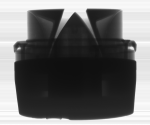Some years ago I had the good fortune to attend a sound systems, acoustics and measurement class instructed by a very knowledgeable guy by the name of Blair McNair. Blair was the national face of TEF when Crown Audio owned it. Gerald Stanley was the genius at Crown that took the two tables worth of components assembled in Richard Heyser’s basement lab, the original “Nyquist” analyzer and made it a portable measurement system. Whenever the new TEF machine would misbehave in public Blair would carry it into Gerald’s office by the power cord and recite to him how “his child" had embarrassed him in public or simply tell him, "Your child is dead." Blair is a very fun guy.
One of the projects of our multi day class was loudspeaker measurement, analysis and tuning. Blair had a pair of what he called the world’s most highly modified (......?) monitors as they had a myriad of switches in the back that could bypass any of the passive crossover components and switch the polarity of the two drivers. The system used was a BSS Sound Webb and a Small Crown amp with audio files from a computer.
One of the exercises was to sweep the drivers individually (without taking them out of course) and then sweep the complete speaker as it was delivered from the factory and determine the crossover slopes and driver polarity, native wide band response etc. He then went on to bypass all the passive parts and created a bi-amp crossover, delay, EQ routine using the BSS Sound Web (forgot the model number). The crossover slopes, splits and EQ was not anything I would have called text book at that point in my studies but this was quite a revelation in what is possible with the right equipment and more than a little knowledge. The difference was stunning; this was unanimously agreed upon by the class via direct comparison of the identical unit beside it.
It's amazing what is now available in the way of electronic crossovers and system controllers. The instructions elaborate how to use the box and all the things you can do with their magic box but what is equally amazing (at least to me) is the apparent lack of information, at least easily found in depth information on how to really do it. I guess that's not quite true, that would be well beyond the scope of the user manual of such a box. What is really required is a knowledge spanning several disciplines, of measurement systems and methods, transducers and emissions, acoustics and filters.
The reason I bring all this up is, on Pro Sound Web there is an article, actually the beginning of a promising series that speaks of and for those whose minds respond to the visual, shows how the above subject is accomplished, or at the very least, it is a good primer. The article is in its second part and I would guess should have a couple more parts to come to cover the subject in reasonable detail.
I know I have much to learn and hope this spurs some conversation.
All the best.
http://www.prosoundweb.com/article//...dspeakers_dsp/
http://www.prosoundweb.com/article//...al_processing/






 Reply With Quote
Reply With Quote